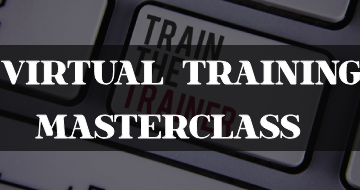IIRF Online > Teaching & Academics > Teacher Training > Train the Trainer > Train the Trainer Virtual: Virtual Training Master Class
Train the Trainer Virtual: Virtual Training Master Class by Udemy
Lead Effective Online, Virtual Training Sessions that Create Excitement, Motivation, Attention and Retention.
Course Highlights
- Create a personal connection with your audience and open with credibility and rapport in a virtual setting.
- How to virtually gain audience’s attention quickly; capture their ‘buy in’, comfort their fears and overcome their resistance.
- How to engage a virtual audience with tools that keep them interested and on pace, no matter who is in the training.
- Engage all trainees in the class, when learning needs and styles are so different and have them visually interested in something that I’m teaching remotely.
- Why it’s essential to ensure they’re following along, understanding, and getting support they need and the mistakes most virtual trainers do that you can avoid.
- Maintain excitement and energy in your virtual training if you want to know how much you can afford to create new online training at your company).
- How to use the right visual aids effectively so you can still write on the “board” use “sticky notes” and get trainees to write things down.
- A 4-step method to be sure your participants can perform critical tasks they need to do before, during and after the training is finished.
- How to remotely assist participants who are struggling so that you can focus on teaching and they can focus on learning that sticks.
- How to provide trainees with activities that they can do alongside the course that presents you with feedback of their progress.
- Why you must get interaction from participants, and how to use the “Interaction Toolkit” to find out what’s REALLY going on in your virtual training.
- How to maintain excitement about the topic and continue to connect with your audience even when you can’t physically interact with them.
- How to set an appropriate pace and pick up on the cues of when to slow down, speed up, mute the audience or repeat, etc…?
- How to manage questions and answers using metrics like the hot seat, the chat, the poll, the phone, the buddy system and our custom Q&A checklist.
- How to keep a finger on the pulse of your technical issues and how to troubleshoot and manage technical difficulties when they do arise.
- Track and confirm they are getting the material and practicing when they need to be so that it does not just become a demonstration.
- How to prepare for a virtual training session so that you always have a plan that works from the curriculum to technical setup.
Skills you will learn!
Curriculum
3 Topics
Introduction to Virtual
Getting to Know You and Your Goals
The Keys to a Successful Class
6 Topics
Give Your Introduction
Find Out About The Trainees
Set Boundaries and Expectations
Send Them to Break
Bring Them Back from Break
Open Well Quiz
13 Topics
Activity: Be an Engaging Presenter
What Makes a Virtual Class Engaging?
Use Hot Seat Drivers
Use Targeted Directionals
Ask Screen Questions
Ask Expertise Questions
Ask Leading Questions
Ask Relevance Questions
Ask Recall Questions
Paraphrase Trainee Responses
Agree and See if You're Right
Use Effective Tone
Teach an Engaging Lesson
1 Topic
Review/Q&A Part I
5 Topics
Determine Who's Attentive
Ensure They Are Following Along
Ensure They Are Remembering
Ensure They Are Understanding
Ensure They Got It Quiz
3 Topics
Activity: Maintain Credibility and Rapport
Top Five Ways to Build Credibility and Rapport
Maintain Credibility and Rapport Quiz
5 Topics
Introduce the Activity
Do Activity Follow Along Checks
Do Activity Benchmark Checks
Do an Activity Oral Review
Facilitate an Activity Quiz
3 Topics
Handle Questions Part I
Handle Questions Part II
Handle Questions Quiz
2 Topics
Manage Technical Issues
Manage Technical Issues Quiz
2 Topics
Prepare Thoroughly
Prepare Thoroughly Quiz
2 Topics
Close Well
Close Well Quiz
2 Topics
Review/Q&A Part II
Virtual Training Exam

Train the Trainer Virtual: Virtual Training Master Class


